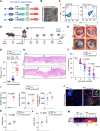Macrophage-Derived Extracellular Vesicles: A Novel Therapeutic Alternative for Diabetic Wound
- PMID: 40343196
- PMCID: PMC12060905
- DOI: 10.2147/IJN.S518655
Macrophage-Derived Extracellular Vesicles: A Novel Therapeutic Alternative for Diabetic Wound
Abstract
Diabetic wounds represent a significant clinical and economic challenge owing to their chronicity and susceptibility to complications. Dysregulated macrophage function is a key factor in delayed wound healing. Recent studies have emphasized the therapeutic potential of macrophage-derived extracellular vesicles (MDEVs), which are enriched with bioactive molecules such as proteins, lipids, and nucleic acids that mirror the state of their parent cells. MDEVs influence immune modulation, angiogenesis, extracellular matrix remodeling, and intercellular communication. In this review, we summarize and discuss the biological properties and therapeutic mechanisms of MDEVs in diabetic wound healing, highlighting strategies to enhance their efficacy through bioengineering and advanced delivery systems. We also explore the integration of MDEVs into innovative wound care technologies. Addressing current limitations and advancing clinical translation of MDEVs could advance diabetic wound management, offering a precise, effective, and versatile therapeutic option.
Keywords: diabetic wound; extracellular vesicle; macrophage; nanomedicine; therapy.
© 2025 Shi et al.
Conflict of interest statement
The author(s) report no conflicts of interest in this work.
Figures





Similar articles
-
Bioengineered Extracellular Vesicle Hydrogel Modulating Inflammatory Microenvironment for Wound Management.Int J Mol Sci. 2024 Dec 5;25(23):13093. doi: 10.3390/ijms252313093. Int J Mol Sci. 2024. PMID: 39684803 Free PMC article.
-
Mesenchymal stem cell-derived extracellular vesicles accelerate diabetic wound healing by inhibiting NET-induced ferroptosis of endothelial cells.Int J Biol Sci. 2024 Jun 17;20(9):3515-3529. doi: 10.7150/ijbs.97150. eCollection 2024. Int J Biol Sci. 2024. PMID: 38993565 Free PMC article.
-
Advanced Drug Delivery System for Management of Chronic Diabetes Wound Healing.Curr Drug Targets. 2023;24(16):1239-1259. doi: 10.2174/0113894501260002231101080505. Curr Drug Targets. 2023. PMID: 37957907 Review.
-
Immunomodulation effects of collagen hydrogel encapsulating extracellular vesicles derived from calcium silicate stimulated-adipose mesenchymal stem cells for diabetic healing.J Nanobiotechnology. 2025 Jan 27;23(1):45. doi: 10.1186/s12951-025-03097-4. J Nanobiotechnology. 2025. PMID: 39865263 Free PMC article.
-
Extracellular vesicles: Emerging frontiers in wound healing.Med Res Rev. 2022 Nov;42(6):2102-2125. doi: 10.1002/med.21918. Epub 2022 Jun 27. Med Res Rev. 2022. PMID: 35757979 Review.
References
Publication types
MeSH terms
LinkOut - more resources
Full Text Sources

